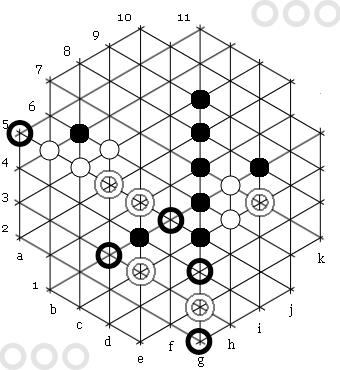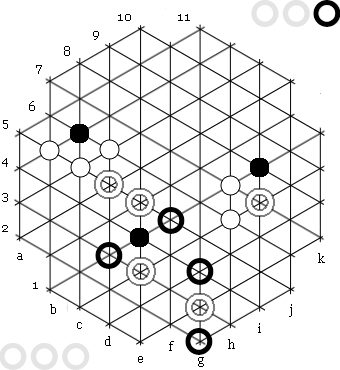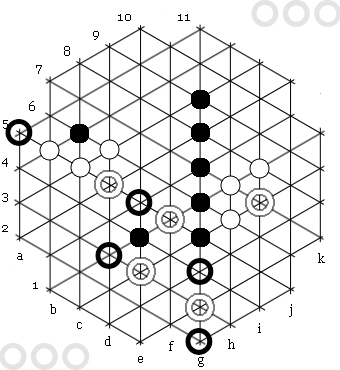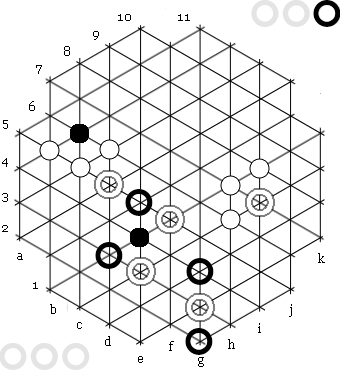|

There are two ways to note down a game of Yinsh: a short and a complete way. The difference between the two methods is that in the long method you always write down exactly which five markers are removed and using the short form you only write it down if the choice is ambiguous.
In general:
- Order the moves with odd digits for the first player and with
pair digits for the second player. (Not as e.g. in chess, where
the moves of both players are counted together.)
- To indicate a space on the board, always first put the letter
to point out the vertical row, next the digit to mark the space.
Small letters are preferred in notations.
For example: 1.a2
- Put a hyphen (that is a "-")
between two coordinates of a move.
For example: 24.a2-h9
- Also use a hyphen between the coordinate of the first marker
of a row and the last marker.
For example: row a3-e3 also includes the spaces b3, c3 and d3.
- Use an "x" to indicate
removing a row and a ring from the board.
- Use a semicolon (that is a ";")
to separate different parts of one and the same move.
- To put coordinates in the right order (when indicating the
first and the last marker of a row that must be removed) always
first use the alphabetical order of the letters, next the climbing
sequence of the digits.
Examples: f3-f7 (not f7-f3) or c2-g6 (not g6-c2)
1. Start of the game / placing the rings:
Note down the co-ordinate of the spot on which you
put a ring:
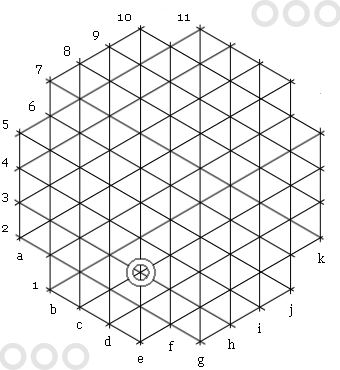
Diagram 1: White places
the first ring on the board.
Note down: 1.e3
2. Putting a marker on the board, moving a ring
Note down the starting and ending coordinates of the ring to being moved separated by a hyphen. Jumping over one or more markers does not affect the notation.
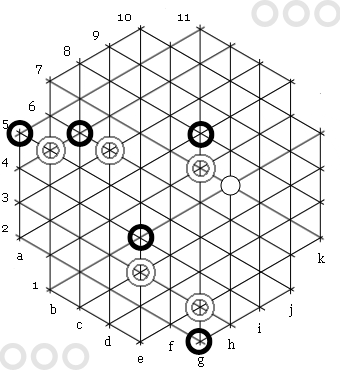 |
Diagram 2:
All the rings are placed on the board and the first move is
made. |
| |
|
| White |
Black |
| 1.e3 |
2.a5 |
| 3.b5 |
4.c6 |
| 5.d6 |
6.e4 |
| 7.h7 |
8.g2 |
| 9.g3 |
10.g8 |
| 11.h7-g7 |
|
| |
|
3. Removing a row and a ring
If your move causes a row of five markers to be formed, you add to your move a semicolon followed by an x and the coordinate of the ring to be removed.
|
|
|
Diagram
3a: Black makes a row
by jumping over two markers. |
|
Diagram
3b: Black must remove
the five markers and a ring. White to move. |
| |
|
|
| White |
Black |
| 1.e3 |
2.a5 |
| 3.b5 |
4.c6 |
| 5.d6 |
6.e4 |
| 7.h7 |
8.g2 |
| 9.g3 |
10.g8 |
| 11.h7-g7 |
... |
| ... |
24.i8-f5;xa5 |
You may follow this immediately by an x and the range of markers being removed. In the long form this is always done, while in the short form it is only added if there is more than one possible way to remove the markers (e.g., if the move forms a row of six or more).
The long form of the move given in the diagram above would
be:
24.i8-f5;xg5-g9xa5
g5 and g9 are the first and last marker of the row, a5 is the removed
ring.
In the event that your move causes two rows to be formed, you add another semicolon an x followed by the coordinate of the second ring and possible the coordinates of the second row. A third ring would be added similarly.
4. When the opponent makes a row of your color.
In the case in which the previous opponent's move had left a row of your color, you indicate this before your normal move. Note down the x followed by the ring to remove and possibly the coordinates of the row of markers to remove before your move. Next you add asemicolon followed by you move.
|
|
|
Diagram
4a: White jumps over two markers and makes a five-in-a-row
for Black |
|
Diagram
4b: Black must remove the five markers and a ring.
Black to move |
| |
|
|
(Attention! Although these diagrams
look like diagram 3a and 3b, they do not show the same game.) |
| |
|
| White |
Black |
| 1.e3 |
2.a5 |
| 3.b5 |
4.c6 |
| 5.d6 |
6.e4 |
| 7.h7 |
8.g2 |
| 9.g3 |
10.g8 |
| 11.h7-g7 |
... |
| ... |
... |
| 23.i8-f5 |
24.xa5;d3-b3 |
The above is again the short notation. The complete notation would
be:
24.xg5-g9xa5;d3-b3
5. When your must remove more then 1 row.
There are 3 possibilities:
1. You form 2 rows with one move
Examples of notations:
Short 23.i8-f5;xa5;xg2
Complete 23. i8-f5;xg5-g9xa5;xa5-e5xg2
2. Your opponent forms 1 row for you, and next you form
a 2nd row yourself
Examples of notations:
Short 23.xa5;i8-f5;xg2
Complete 23.xg5-g9xa5;i8-f5;xa5-e5xg2
3. Unlikely but it is possibly: your opponent forms 2 rows
for you
Examples of notations:
Short 23.xa5;xg2;i8-f5
Complete 23.xg5-g9xa5;xa5-e5xg2;i8-f5
If a player would form 3 rows with one and the same move, use the
same principles as for 2 rows.
|


